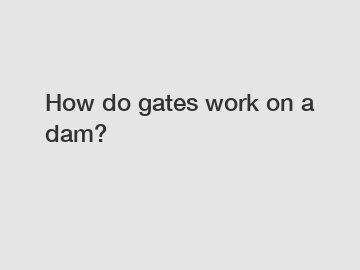How do gates work on a dam?
How do gates work on a dam?
Gates play a crucial role in controlling the flow of water on a dam. In simple terms, gates are mechanisms that can be opened or closed to regulate the amount of water passing through a dam. The operation of gates on a dam involves a complex process that is essential for the proper functioning of the structure.
The gates on a dam are designed to either hold back the water or allow it to flow through. When the gates are closed, they create a barrier that prevents the water from passing through, effectively creating a reservoir. This enables the dam to store water for future use, such as irrigation or hydroelectric power generation. On the other hand, when the gates are opened, water is released downstream, either to control flooding or to generate power.

The operation of the gates relies on the principle of hydrostatic pressure. When the gates are closed, the pressure exerted by the water against them increases. This pressure is proportional to the depth of the water behind the gates. To prevent the gates from being pushed open by the force of the water, they are equipped with special mechanisms, such as seals and locking systems. These mechanisms ensure that the gates remain closed even under high water pressure.
To open or close the gates, dam operators use a variety of methods depending on the size and design of the dam. Some dams have manual gates that are operated by physically turning a wheel or using a lever. Others, especially larger dams, have automated gates that can be controlled remotely. These automated gates are often operated using hydraulic systems, where the pressure of oil or water is used to move the gates.
The proper operation of gates on a dam is of utmost importance for the safety and efficiency of the structure. Failing to regulate the flow of water correctly can have severe consequences, such as flooding or the failure of the dam itself. Therefore, meticulous planning and regular maintenance are vital in ensuring that the gates function properly.
In conclusion, gates on a dam work by either holding back or releasing water, depending on their position. The operation of gates involves the principle of hydrostatic pressure and requires the use of special mechanisms to withstand the force exerted by the water. Proper regulation of water flow through the gates is crucial for the safety and functionality of the dam. By understanding how gates work on a dam, we can appreciate the engineering behind these structures and their impact on our daily lives.
For more Environmental Protection Inflatable Rubber Dam, Containerized Water Purification Plant supplier, Environmental Flow Regulation And Control Weirinformation, please contact us. We will provide professional answers.


